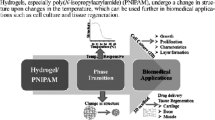Abstract
Purpose
To demonstrate remote controlled degradation of degradable nanocomposite hydrogels by application of an alternating magnetic field (AMF). Further, it was desired to study the AMF effect on the drug release properties of these systems.
Methods
Degradable nanocomposite hydrogels were synthesized by incorporating iron oxide nanoparticles into a degradable hydrogel that exhibited temperature dependent degradation. Heating, degradation, and drug release studies were conducted by application of an AMF to determine if modulation of degradation and drug release could be attained.
Results
Hydrogels were successfully prepared, shown to have temperature dependent degradation, and shown to heat when exposed to the AMF. The degradation rate of the exposed samples was demonstrated to be higher than control samples, thus modulation of degradation was obtained. The release of a model drug from the system was modulated by exposure to the AMF.
Conclusions
This is the first demonstration of remote controlled degradation using an AMF stimulus. Here, the proof of the concept has been presented, and there is great potential to enhance this effect through various methods. The ability to remotely control degradation of an implanted device opens a new area of improved medical devices.







Similar content being viewed by others
References
L. S. Nair, and C. T. Laurencin. Biodegradable polymers as biomaterials. Prog. Polym. Sci. 32(8–9):762–798 (2007). doi:10.1016/j.progpolymsci.2007.05.017.
J. Kopecek. Smart and genetically engineered biomaterials and drug delivery systems. Eur. J. Pharm. Sci. 20(1):1–16 (2003). doi:10.1016/S0928-0987(03)00164-7.
C. C. Lin, and A. T. Metters. Hydrogels in controlled release formulations: Network design and mathematical modeling. Adv. Drug Deliv. Rev. 58(12–13):1379–1408 (2006). doi:10.1016/j.addr.2006.09.004.
K. R. Kamath, and K. Park. Biodegradable hydrogels in drug-delivery. Adv. Drug Deliv. Rev. 11(1–2):59–84 (1993). doi:10.1016/0169-409X(93)90027-2.
N. A. Peppas, et al. Hydrogels in biology and medicine: From molecular principles to bionanotechnology. Adv. Mater. 18(11):1345–1360 (2006). doi:10.1002/adma.200501612.
J. D. Kretlow, L. Klouda, and A. G. Mikos. Injectable matrices and scaffolds for drug delivery in tissue engineering. Adv. Drug Deliv. Rev. 59(4–5):263–273 (2007). doi:10.1016/j.addr.2007.03.013.
L. G. Griffith. Polymeric biomaterials. Acta. Mater. 48(1):263–277 (2000). doi:10.1016/S1359-6454(99)00299-2.
B. D. Ratner, and S. J. Bryant. Biomaterials: Where we have been and where we are going. Annu. Rev. Biomed. Eng. 6:41–75 (2004). doi:10.1146/annurev.bioeng.6.040803.140027.
A. S. Sawhney, C. P. Pathak, and J. A. Hubbell. Bioerodible hydrogels based on photopolymerized poly(ethylene glycol)-co-poly(alpha-hydroxy acid) diacrylate macromers. Macromolecules. 26(4):581–587 (1993). doi:10.1021/ma00056a005.
D. G. Anderson, et al. A combinatorial library of photocrosslinkable and degradable materials. Adv. Mater. 18(19):2614–2618 (2006). doi:10.1002/adma.200600529.
D. M. Brey, I. Erickson, and J. A. Burdick. Influence of macromer molecular weight and chemistry on poly(beta-amino ester) network properties and initial cell interactions. J. Biomed. Mater. Res. Part A. 85A(3):731–741 (2008). doi:10.1002/jbm.a.31494.
N. Harris, M. J. Ford, and M. B. Cortie. Optimization of plasmonic heating by gold nanospheres and nanoshells. J. Phys. Chem., B. 110(22):10701–10707 (2006). doi:10.1021/jp0606208.
I. K. Tjahjono, and Y. Bayazitoglu. Near-infrared light heating of a slab by embedded nanoparticles. Int. J. Heat Mass Transfer. 51(7–8):1505–1515 (2008). doi:10.1016/j.ijheatmasstransfer.2007.07.047.
R. A. Frimpong, S. Fraser, and J. Z. Hilt. Synthesis and temperature response analysis of magnetic-hydrogel nanocomposites. J. Biomed. Mater. Res. Part A. 80A(1):1–6 (2007). doi:10.1002/jbm.a.30962.
N. S. Satarkar, and J. Z. Hilt. Hydrogel nanocomposites as remote-controlled biomaterials. Acta. Biomaterialia. 4(1):11–16 (2008). doi:10.1016/j.actbio.2007.07.009.
N. S. Satarkar, and J. Z. Hilt. Magnetic hydrogel nanocomposites for remote controlled pulsatile drug release. J. Control. Release. 130(3):246–251 (2008). doi:10.1016/j.jconrel.2008.06.008.
L. L. Lao, and R. V. Ramanujan. Magnetic and hydrogel composite materials for hyperthermia applications. J. Mater. Sci., Mater. Med. 15(10):1061–1064 (2004). doi:10.1023/B:JMSM.0000046386.78633.e5.
R. Hergt, et al. Magnetic particle hyperthermia: nanoparticle magnetism and materials development for cancer therapy. J. Phys., Condens. Matter. 18(38):S2919–S2934 (2006). doi:10.1088/0953-8984/18/38/S26.
Acknowledgements
This material is based in part on work supported by the National Science Foundation through an NSF IGERT traineeship and CTS-0609117 (NSF NIRT).
Author information
Authors and Affiliations
Corresponding author
Appendix
Appendix
Rights and permissions
About this article
Cite this article
Hawkins, A.M., Satarkar, N.S. & Hilt, J.Z. Nanocomposite Degradable Hydrogels: Demonstration of Remote Controlled Degradation and Drug Release. Pharm Res 26, 667–673 (2009). https://doi.org/10.1007/s11095-008-9804-z
Received:
Accepted:
Published:
Issue Date:
DOI: https://doi.org/10.1007/s11095-008-9804-z




